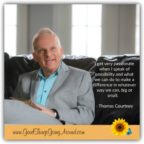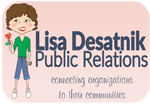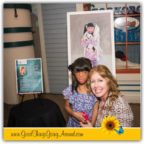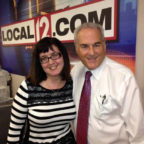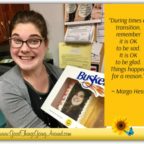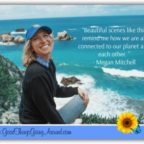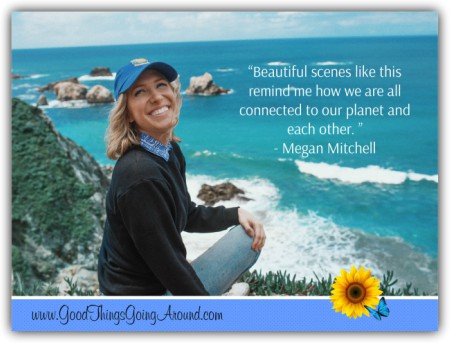featured
The Best Version Of Who We Are
The other day, Thomas Courtney and I met for coffee and he shared a story with me that I thought everyone could benefit from hearing, so I asked him to write about it as a guest post, which is below. Thomas has created and is in the process of bringing to the airwaves, It’s a Good Life – a television show that informs, inspires and provides insight on living a better life.
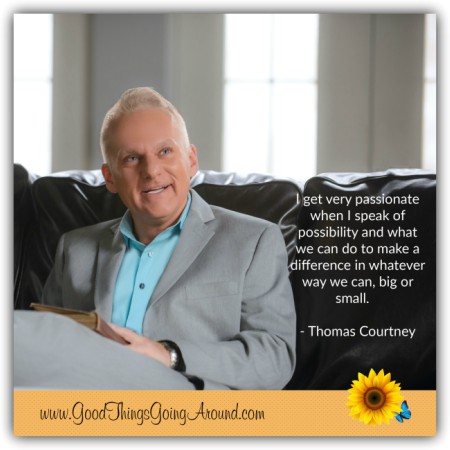 When we wake up in the morning we should say to ourselves, “Today, I am going to make this day, the best day, I have ever had in my life. “
When we wake up in the morning we should say to ourselves, “Today, I am going to make this day, the best day, I have ever had in my life. “
A couple of years ago I was speaking at an education and computer technology conference to a group of K12 through college software writers and developers about the power of making an impact in our communities and our world at large. I shared about children who are living in poverty and homelessness; and about how the number one way we can have the greatest impact on life around us is by being the best version of who we are, right now, in this moment. Not a version of anyone else.
In my conference speech, I told the story of how I would sit and talk with children in their classroom and listen to their stories of what they wanted to be when they grew up. Many of those students were kids who had some behavioral issues stemming from their challenges of living a life that was much more difficult than what the average person was living.
I get very passionate when I speak of possibility and what we can do to make a difference in whatever way we can, big or small. I am passionate because I believe in possibility. And when I spoke to those children who believed they had no hope and no place to turn and no one to turn to and no way out, their eyes lit up like Christmas trees when I told them there is always a way out and a way up.
I said to the children, “In life, moments will come along when you think. ‘I have no chance of getting over this hurdle’.” I told them, “You will think you believe that you do not have what it takes to be whatever it is that you want to be. I am here to tell you that simply is not true. You will be spending the rest of your life constructing your life. Self-construction never stops.
“There will be times when you think you are stuck. And you may likely be. And there will be times when you will be afraid of the unknown. And it is going to feel like you aren’t capable of taking that next step. And you will wonder if you are in charge, or is life in charge of you. Most likely, it will be a little of both. However, if you build a good value system, stick to it, and follow your heart this will give you a foundation to take leaps you may never think you can take. And most importantly, be who you are. Do not try to be anyone else. And be the very best version of who you are.”
When I finished my story, the audience was motionless. Eyes had blank stares and were frozen in time. You could hear a pin drop. Suddenly a hand went up. The woman had this to say, “I can appreciate how passionate you are and the work that you are doing with these children, but I am not in your line of work. I get up every day and do the same thing over and over again, sitting at my computer typing. I have very little to do with anyone else, little alone making a great impact. I think I do my job well, but I wouldn’t necessarily say I am making a difference.”
I briefly paused, thinking about what was said before giving an answer. “Well, let’s go back to what I said to the children about being the best version of you,” I told her, asking how she begins her days.
“I get up after hitting the snooze three times, chuckle, fix my coffee, race to the shower, and may or may not have time for breakfast, and run to my car trying to hurry to make sure I’m not late. Then I realize I am about out of gas and need to stop and fill up my gas tank on my way into the office.,” she told me as the audience laughed. “And it really depends on how late I was out the night before,” she added.
Then I asked her, “Tell me how you feel about your work?,” and she explained, “I love my job. I make a good living. I am doing what I went to school for. This is what I do.”
I paused again for a moment, and then asked, “Do you believe the picture you just painted for me is the best you can be? Do you believe you are being the best version of who you are based on what I explained to the children?”
She was quiet.
I went on, “I do not mean to sound like I have the answers for you and your life. But hear me out for a moment. What if you believed the work that you do, which is creating and building software for K12 through college level as having a serious and critical impact on not only the lives of the children and young adults you build this software for, but on the world? What if you believed the decisions that you make every day in your life impacted the decisions and thought processes of every individual that your work project touches every day and even on different time zones? Would that change how you see yourself and the work that you do every day?”
I could see her mental wheels turning. I could see she was now thinking about a bigger picture. Sometimes, what we all need is to get clarity on what is most important. Sometimes we all need to see that in its simplest form we play a much bigger role in this hamster wheel of life than we would like to think. Self-construction never stops.
We have 86,400 hours in a day to work until we retire, if we retire and depending on when you graduate from high school. But just for conversation sake these are the hours we have. This is time. We should ask ourselves, “Who do we want to be and are we being our very best? Is it the best version of who we are?”
Life is fleeting. Time is invaluable. And since we are so limited then I’d think we would want to spend it becoming the best of who we are, giving the best of which we are, not only for the world, but most importantly for ourselves. The world is our stage. We might as well choose to strive to live happy, develop and perfect our humanity, and celebrate being the best of who we are. Today, I am going to make this day the best day I have ever had in my life.
- Thomas Courtney
Reach Thomas by calling 513.616.0407 or emailing thomas@itsagoodlifeinc.com

Portraying Souls Through Art
Jing was 16 months old, just weeks ahead of playing make believe, running, jumping, and exploring. Only those developmental milestones she was on target for reaching, had to be delayed. The course of her life was about to make a detour that would alter her journey for a very long time.
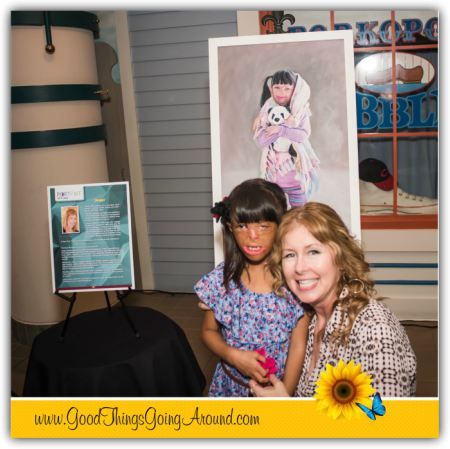 Jing was born to parents who lived in a rural village of southwest China where central electricity and modern plumbing were unavailable. Meals were cooked over an open fire, that one fateful day burned much of the newly mobile infant’s body. By the time Jing celebrated her second birthday, she had already undergone three surgeries.
Jing was born to parents who lived in a rural village of southwest China where central electricity and modern plumbing were unavailable. Meals were cooked over an open fire, that one fateful day burned much of the newly mobile infant’s body. By the time Jing celebrated her second birthday, she had already undergone three surgeries.
Her story traveled to the United States via the media and internet, and eventually led her to Cincinnati, one week past her second birthday in 2012, where she has been living with a host family and receiving treatment from Shriner’s Hospital for Children – Cincinnati.
Her injuries caused airway obstruction which made it difficult to stay asleep for longer than 90 minutes at a time. She had lost vision in one eye, and the Chinese hospital had fused the lid. Jing’s mouth was so contracted from scar tissue that she could only consume bottles of formula. Over the next year, Kevin Yakuboff M.D., FACS, FAAPS, surgically released Jing’s mouth and neck, which allowed her to enjoy solid food for the first time. (Meatballs were a favorite!) He corrected her eyelid for a more symmetric and balanced appearance. By her third birthday, Christopher Gordon M.D., FACS, FAAP surgically altered her jaw, a major advancement which opened her airways and allowed her to sleep through the night for the first time.
An ocean separating them, when it had become clear that it was in Jing’s best interest to stay in Cincinnati near to her medical team, her parents wanted that for their daughter, and Jing’s host family became her adopted family.
Enter Portrait of a Soul
It is children like Jing who give Cincinnati philanthropists Lee and Sue Schaefer purpose. Four years ago they founded Portrait of a Soul, a nonprofit organization which partners with elite artists to create beautiful, fine art portraits of children with craniofacial conditions or other differences.
“For a child, having a portrait of him or herself, tells them ‘you matter, you are important’,” Lee told me. “We had a little girl who looked at her portrait and said she couldn’t believe an artist touched that portrait 100,000 times just for her. Most of the kids want their scar showing but don’t always have to. We just want it to be a positive, uplifting experience for them. The fact that someone cares about them is what they walk away with.”
The first step is meeting with the artist to make sure he/she has a “heart for the project and the child”, something top on the Schaefer’s priority list. Once artists have been paired with a child, they meet and typically the artist will take a lot of photos before going into the studio to illustrate their interpretation of their subject’s soul. Children do not see the finished result until an unveiling event – usually some 4 to 6 months later. It is a process that forms special bonds. Lee and Sue, who have no children of their own, have been to numerous high school graduations, birth parties, plays and other celebrations.
Holly Schapker painted two portraits, one of which was just unveiled at the Down Syndrome Association of Greater Cincinnati. “It is interesting that for so many years, I have been building my skillset and it feels like all my skills have been for this purpose. I don’t see a higher purpose as an artist,” she told me.
Jing loves art and reading, and panda bears. And, now, after the unveiling of her portrait by Tracey Ellis-Haynes at Shriner’s Hospital, the world will know that too (as a high quality reproduction will hang at Shriner’s Hospital and Jing has the original). “I love it because it has my stuffed panda, Xi Xi, in it. Then everybody can see her. I am proud because my artist did a great job,” she told me.
I asked Lee how their nonprofit has impacted him and his wife. “We are very humbled by it,” he said. We don’t want the project to be about Sue and me. This is our way of giving back. We have gotten more out of it than we ever thought. It is the neatest thing that we have ever done.”

Anita’s Gift Saved Howard’s Life
For many years Local 12’s Troubleshooter Howard Ain was the problem solver for thousands – those he assisted first hand and many more who benefited from his advocacy through watching his television segments.
And, as it goes in life, you never know when your role will change from the giver to the recipient. You may have heard by now that Howard was battling a 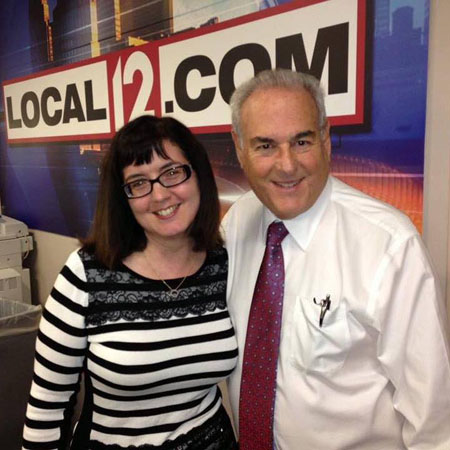 chronic kidney disease, and like millions of others across the United States, he was in need of a kidney transplant. (A close friend of mine is among those millions too, and also received a kidney transnplant.) It was only the end of June when his story became widespread news via his longtime employer and just like that, those people who benefited from his work wanted to help.
chronic kidney disease, and like millions of others across the United States, he was in need of a kidney transplant. (A close friend of mine is among those millions too, and also received a kidney transnplant.) It was only the end of June when his story became widespread news via his longtime employer and just like that, those people who benefited from his work wanted to help.
Many were tested to see if they were a match. Ultimately, his living donor was a producer whose Local 12 newscasts shared his stories for all those years. I’ve known Anita Bray Farrell for a while through social media. I’ve seen her big heart toward animals. Now her generosity has saved a human life, the life of a respected and dear colleague – and friend.
In a news story on Local 12, I saw this conversation:
“Hard to believe that I could get my life back,” said Howard.
“The more I thought about it, he’s helped a lot of people, for decades, literally I think he’s saved some people from financial ruin, and I wanted to pay it back a little bit,” said Anita.
“My biggest fear is that there would be a complication for Howard, not for me,” said Anita.
“I’ve known Anita for years, she is a woman of uncommon grace,” said Howard.
Howard has a little bit of that fear, too, but what do you say to a person that saves your life? (from Liz Bonis)
“You know what she said to me? Because you know, the producers are always saying ‘can I give it a little bit more time, a little more time, my story is going to run a little long’ while she said it’s the first time a producer has ever given a reporter more time, okay I’ll give you more time and it’s not minutes, it’s years,” said Howard.
There is a lesson in here for all of us.
When I spoke with Anita, this is what she told me, “If you are healthy, I would definitely encourage people to do it. It is some time off work, some pain, the testing process is involved but something to consider. Is well worth it to save a life and give something back.”
To learn more about being a kidney donor, please visit this link for the National Kidney Foundation.

Lessons From Transitions
Before Labor Day, my Toast of the Town Toastmasters Club lost one of our dearest members. Several years after her first meeting, after having served as our Club’s VP of Education (the most time intensive of our Board positions), inspiring and uplifting us with her humorous and thoughtful speeches, critiques, and leadership, she gave us her last farewell speech. Margo accepted a dream job for herself, working downtown for Macy’s – which means our Kenwood lunch time meetings no longer fit into her schedule. Margo’s speech was about transitions. As could be expected, it was insightful and powerful. Its messages are ones we all can learn from and live by. I recorded it and am sharing the transcript below.
Transitions by Margo Hess
One of the things that I have taken away from my 2 years at Centennial Inc. is that we are always in a time of transition. Think about that.
You are always either in transition or thinking about what is next. How many of you can say that where I am today is definitely where I will be next year – whether it be personally, professionally or whatever financial goals you have?
It is a big transition for me but it is a time of transition for everyone in this room.
About a year and a half year ago I came to my first Toastmasters meeting at the arm of Becky. She said you are going to go to this meeting and it is going to 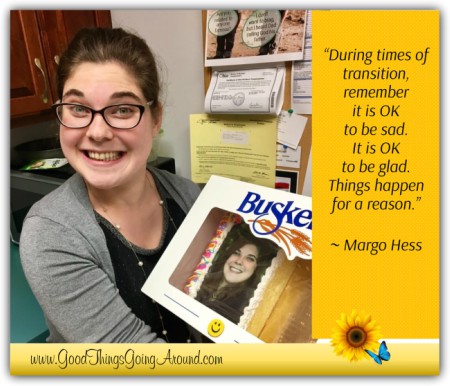 be good for you. And I sat in the back. She made me put my name in for table topics. I groaned. At the first meeting, guess what happens, I got picked.
be good for you. And I sat in the back. She made me put my name in for table topics. I groaned. At the first meeting, guess what happens, I got picked.
Now here we are and it is my 10th speech. That in itself is transition.
Transitions can be bitter sweet. There is the excitement of something new, what is next, who am I going to meet, what am I going to do, what am I going to accomplish. But there is this sad part. The ‘this is my last time I am going to do this or the other. Or the last time I will see this person on a regular basis. The last time I will pull into this parking spot. Even the last time I will likely be at this meeting.’ Those are the sad parts.
Through it all, you have to remember that it is ok to be sad. And it is ok to be glad. Things change for a reason.
So it is during those times of transition when you need to focus on a few simple rules:
Think about what and who got you here. For me personally, there is a long list. My family, my grad school mentor, my college friends who kept a light even when I was unsure. We all need those people. But I think it is not enough to reflect on those people. I think you need to thank those people and let them know they inspired you. And let them know they mattered. And then take it a step further and see if you can inspire them back. Also think about where do you come from, what got you here.
This next opportunity is a passion for me. It is a mix of things. It is everything I have learned at Centennial. It is the start of me as a celebrity at the Old Navy through a weekend sales person at Bath and Body to a manager. The marriage of those things. It is the use of my masters degree.
It seems like it is one big jump but it is made up of a lot of little steps. Transition is just a big goal that is divided into chunks. It is the what and the where and the people that got you there.
I think that is the sad part .It is sad and happy at the same time because you are thinking about the people that matter to you and you are thinking about the sequence of events that got you there, all the random lunches with your work family, all the nights with your friends, and all the work in between.
And that is ok. You are supposed to think about that. Because it matters and you are supposed to feel thankful for that.
But there is the second part to that. It is ok to be sentimental. You should also be really excited. It is ok to move on and it is ok to move forward because it is not like you are just disappearing off the face of the earth. Especially in this day and age. You can communicate with anyone.
Just because you move on, that does not mean that you lose those people. Instead, it is time to connect with the new people whether it be bonding over cooking, couponing or alligators at the zoo, it is connecting.
You are keeping your old friends and making new friends. Connecting over common interests and realizing that the next step is here and you can do it. You have taken all these steps, all these people, these places and you are ready.
Be excited. Be sad. It’s ok.
Finally, it is realizing it will not be your last transition. So be sad. Have your last lunch. Know there will be another last lunch and another first lunch. And then another last and another first. And enjoy all that because that is what is going to make you who you are. If you can take that and share that with others, then maybe transition won’t always be so scary. Maybe transition is a good thing. Maybe it allows other people to step up to the plate and be there best.
I encourage all of you to think about your personal transitions, where you are today, and what got you there; and where you want to be tomorrow and what will get you there. Say thank you to those who helped you, help someone else, and just have fun and laugh a lot because life is too short not too.
And to Margo, I want to say thank YOU for pushing me to keep scheduling my speeches, for your encouraging words and smiles, for your laughter and your insight….for just being you! I, and all of us at Toast of the Town will miss you!

Megan Raises Voices Of Unheard
I met Megan Mitchell for the first time one morning when I had stopped by their newsroom earlier this year to talk about the 2017 ReelAbilities Film Festival. I had asked for suggestions of news staff who may be interested in helping to emcee our screenings, and was pointed in the direction of their newest news anchor.
They say first impressions are so telling when it comes to making judgements about people. And I will always remember how that first conversation began Megan and myself. She was sitting at her desk, turning her attention to me as soon as I sat down. She had this incredible enthusiasm about herself that infectiously made my energy soar. As I spoke about the Festival, her eyes seemed to have a sparkle. “Oh, I know her. I LOVE that show! Wow, I saw her on Broadway!,” where among her comments when the names of our VIP guests came up.
Megan not only emceed a screening for us this year, she also co-hosted our Kick Off Party, and arrived early at the Festival to conduct Red Carpet interviews with two of the stars she admired most.
Having her in your presence just makes that moment and that day so much fun. And that attitude about life is so very genuine. Clearly Megan has a huge heart. a huge appreciation for her relationships, and a deep passion for telling the stories of those whose stories need to be told with dignity and respect.
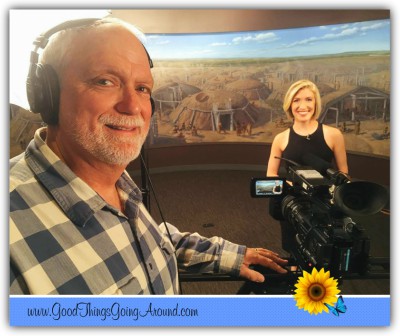 It is all those qualities that have made her a such a popular news anchor. Originally from Brookfield, Connecticut, Megan interned at MSNBC and MTV in New York City during college. She is a proud alum of Emerson College where she received an AP Award for Best Documentary for a half-hour show she executive produced on the Primetime Emmy Awards, and an EVVY Award for Best Television Personality. From there she has gone on to win numerous other awards, and her most recent (and probably most proud) award was First Place our of every local news station in the country (major markets included) by the National Association of LGBTQ journalists for a documentary she made with Cliff Naylor on Two Spirit and/or LGBTQ Native Americans. She and Cliff also received 1st place in the Eric Sevareid Awards and the Associated Press – Great Plains Awards for that documentary, which, is important to mention, they created on their OWN time, without compensation because they felt so strongly that the story needed to be told.
It is all those qualities that have made her a such a popular news anchor. Originally from Brookfield, Connecticut, Megan interned at MSNBC and MTV in New York City during college. She is a proud alum of Emerson College where she received an AP Award for Best Documentary for a half-hour show she executive produced on the Primetime Emmy Awards, and an EVVY Award for Best Television Personality. From there she has gone on to win numerous other awards, and her most recent (and probably most proud) award was First Place our of every local news station in the country (major markets included) by the National Association of LGBTQ journalists for a documentary she made with Cliff Naylor on Two Spirit and/or LGBTQ Native Americans. She and Cliff also received 1st place in the Eric Sevareid Awards and the Associated Press – Great Plains Awards for that documentary, which, is important to mention, they created on their OWN time, without compensation because they felt so strongly that the story needed to be told.
“Two Spirits” is a documentary that examines how a 2015 U.S. Supreme Court decision on same-sex marriage did not settle the contentious subject for sovereign nations. Tribal courts are not affected by the ruling. Eleven Native American tribes, including the two largest, the Navajo and Cherokee Nations, still prohibit gay marriage. Only a dozen of the 566 recognized Indian nations recognize same-sex marriage. None of the four tribes in North Dakota issue same-sex marriage licenses. “Two Spirits” examines how Native American attitudes on marriage have evolved, how the topic continues to divide reservations, and the tragic consequences, such as suicide, that result because the issue is still unresolved for Native people.
(You can watch the documentary here: https://youtu.be/eaIWR27sg1c).
When I asked Megan what makes her the most proud of her work on that documentary, she told me, “I feel proud of the Two Spirit documentary because it was a true showcase of why I got into the news business and the work I want to do through storytelling. I always hope I can give a platform to the subjects and allow them to tell their own story, as opposed to me taking their voice from them. And I feel the documentary does that well.”
Let’s get to know a little more about Megan.
Lisa: That documentary was so important to you, and giving a platform to difference. Why is that important to you?
Megan: It is great to celebrate difference. I love being different, it makes me, me. We don’t all think alike but that is the beauty of it. Being different provides a bit of empathy because you learn that things are not just one way, and your heart grows as you learn you can love and be loves as truly you.
Lisa: And this is what makes you such a real journalist.
Megan: My favorite part of my job is being able to strip away the layers to see everyone as human beings. I feel like the best way to tell a story is by providing a voice for each side. If there is one that is not as heard or not as privileged, it is important to raise those voices and be heard equally. We tend to dehumanize people we see as different from ourselves so that human connection can make you see someone as you see yourself. When I talk to people, I get to hear a side that not everyone does, which is so valuable.
Lisa: You are someone with such a positive outlook. Where does that come from?
Megan: My parents. My mom was literally a cheerleader growing up. All she wants to do is look at everything in the best light. Whenever something bad happened to us, she would tell us, “This too shall pass. We’ll laugh about this someday.” You know, she was right.
My dad too was always like, “keep moving forward.” I look back at baby videos of myself and my parents were so animated. They sounded like they were talking to a baby puppy. That is why I am an animated person because they were so excited they had a kid.
Lisa: I love this photo of you. Please tell me why this is so special to you.
Megan: I was traveling the California coast on the Pacific Coast Highway and was in Big Sur for this photo. I find so much beauty in nature. I think all of us want to feel like we’re a part of something bigger and greater, and I feel at home when I am reminded I am an inhabitant of this Earth. I even believe I said to my best friend in this photo “I feel so comfy and cozy right now.” Beautiful scenes like this remind me how we are all connected to our planet and each other. That’s why I love to travel. To remind myself with all the bad news out there, there is always something greater that connects us all and we’re living in it.

